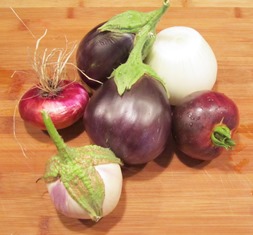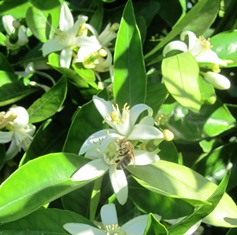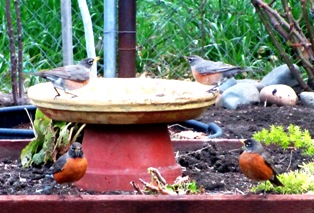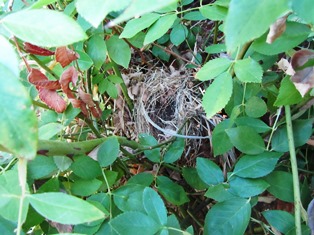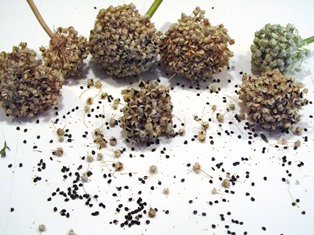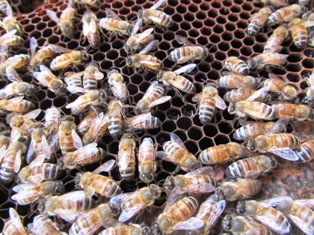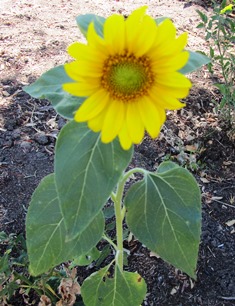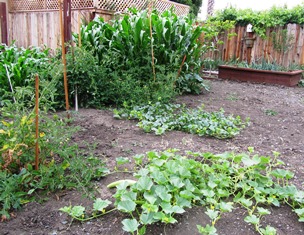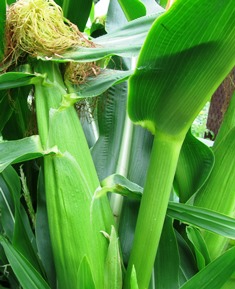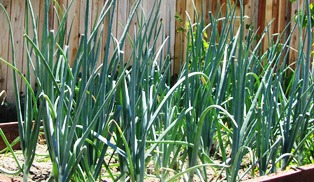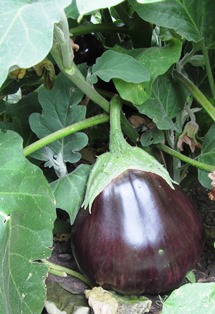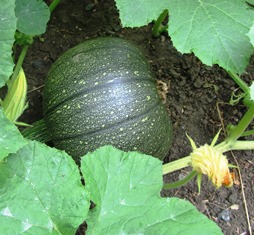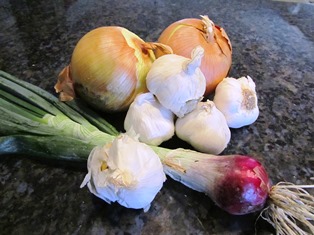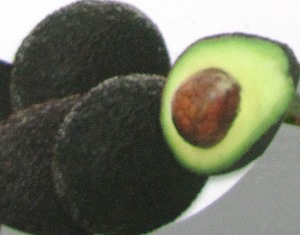Archive for the 'Gardening' Category
Could the Weird Weather Be Affecting Our Crops?
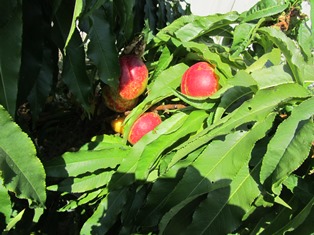
Nectarines are ripening but the tree recently developed peach leaf curl, noticeable in the top right leaves
Since the beginning of the agrarian age, farmers have understood that weather affects crops. To say the weather this year–at least in Northern California–has been weird is an understatement. I can’t help thinking it’s impacting my garden.
In the last three weeks, my healthy nectarine trees developed that dreaded fungal peach leaf curl, despite the prescribe spraying throughout the dormant season with horticultural oil. I’ve got tomato vines spreading everywhere with few tomatoes. The corn developed such a terrible infestation of corn aphids that I pulled out all the corn and fed it to the chickens.
I’m not blaming the weather for my all garden woes, but it’s got to be a factor in what my neighbors and I are witnessing in our gardens and orchards with regard to less bountiful crops.
We have to water because the soil is so dry it’s cracking open. We have to stay on top of pest infestations as we all grow organic and the bees travel through all of our backyards and up to five miles or so. We share our produce and stories of what’s happening in our gardens so we can deal with the problems.
We had very little rain during our rainy season and now local reservoirs are low. For the last three days, the Bay Area has had over 11,000 dry lightning strikes (putting fire departments on high alert), temperatures inching toward triple digits, and high particulate in the air because of all the wildfires burning in our state and elsewhere in the West.
I heard a recent newscaster using that dreaded word “drought” and lamenting about the low level of water currently available for farmers to use for their crops and orchards, especially in the California’s Central Valley, an area considered an important “bread basket” of the United States. The good news is that those farmers will be winding down their water usage as fall approaches and crops are harvested.
As the weather goes, so do the crops–something farmers and gardeners have always understood. My garden woes likely have a lot to do with the head gardener–that’s me. But I’ve been gardening here for four years and this year’s garden has been the least bountiful. While there are many factors to evaluate, the weird weather has to be considered.
Edible Flowers Add Flavor and A Flourish
Picture a red nasturtium or peppery-tasting marigold displayed around a mound of lemony-yellow butter. Or, imagine the beauty of a handful of sugared purple violets or red rose petals, sans the sour petal base, crowning an iced picnic cake.
During bygone eras when the Romans ruled the world or Queen Victoria reigned during the age named for her, flowers weren’t just for bouquets on the table, they formed an integral part of the food that was consumed.
Many flowers and seeds are poisonous, so it is imperative that you correctly identify any flower or plant you plan to eat or use on food. Also, make sure you are not allergic to the plant before integrating its blooms into your diet.
Several edible florals include the blossoms of herbs such as lavender, dill, garlic chive, coriander, basil, bee balm, marjoram, oregano, anise hyssop, winter savory, summer savory, sage, and mint. Also edible are the flowers of certain varieties of pumpkins, squash, cauliflower, scarlet runner bean, radish, sweet garden pea, and fennel.
Consider also the delicate blooms of society garlic, dianthus, pansy, signet marigold, red clover, African marigold, plum, scented geranium (rose, lemon). You can candy the blossoms of apple and crabapple, but the seeds are poisonous.
Some blooms, such as hibiscus (China rose), mint, rose, and chamomile are used to flavor teas. Lemon blossoms will have a slightly bitter taste whereas orange blossoms are sweet but both are lovely floating in crystal bowls of punch.
Research your chosen plant and correctly identify it before using it in any food preparation. See, http://www.extension.iastate.edu/publications/rg302.pdf
Also see, http://www.ext.colostate.edu/pubs/garden/07237.html
Forget the Lawn and Welcome the Robins
One of my favorite ways to relax is birdwatching. And nothing entertains me more than seeing an orange-breasted robin hopping around on the lawn and then halting at a full stop with its head cocked as if listening for an earthworm, as if the worms telegraphed their presence. I mean seriously. But somehow, those robins will find the worms and pull them right out of the ground.
When winter is nearing its close and spring is beginning, the robins are one of the first harbingers of the seasonal transition. In the spring, when other backyard birds are nesting and producing young, the robins are, too. But even though it is possible for them to produce three broods each year, less than half (40 percent) of their nests will hold baby robins.
Of the young robins that hatch, only about a quarter of them will make it to November each year. And as if that weren’t bad enough, of the robins that make it through a full year, only half will survive through a second year. And yet, robins can live to the ripe old age of 14 if it were not for predators and pesticides.
With the odds against these sweet birds’ survival, you’d think most people would not spray the daylights out of their lawns with pesticides and herbicides. These chemicals are toxic to the robins as well as other birds and, of course, the beleaguered honeybee.
Robins find lawns to be wonderful sites for foraging and I often see them searching and snatching the earthworms in the early morning. Later in the day, these cheerful birds seem to prefer fruit and honeysuckle berries. If you don’t see them, you might hear their cheery song crisp and clear, even over urban noise.
During certain times of the year, you might see the robins in greater numbers than at other times, but that doesn’t mean they’ve gone far. They are either resident birds, meaning they stay close to their breeding area or are short-distance migrants. The local conditions (environmental, weather, water and food availability, predator populations, and other factors) dictate the size of the robin population in at any given time in a particular area.
If you love birds as I do, less fussing over your lawn (except to encourage the worms) might mean having having more robins around. Consider ways to establish a healthy ecological balance in your yard and garden to avoid spraying with chemicals that can poison these cheerful fun-to-watch birds.
Harvesting Onions and Saving the Seeds
This year I grew Red Baron (red) onions from tiny sets. I pretty much just laid the thin little onion strings on the ground and sprinkled a little soil over them. I kept them wet and those little strings turned into really fat bulbs of purplish red onion with tall green stalks.
However, when the plant shot up some stalks that were two to three feet in height and sprouted a globe type bloom, I wasn’t sure what to do.Well, now I realize that those globes hold tiny black seeds that will turn into my next crop of onions.
When the bulbs started to turn a little dry, I clipped them and let them dry a bit more on my patio table. Then I laid them onto some white poster board and shook them vigorously to release the tiny black seeds (about the size of mustard seeds).
I put the seeds into a white paper envelope and then labeled the envelope with the name of the onion and the date the seeds were harvested. I can’t wait now until fall when I can sow the seeds into flats and then plant the new sets.
I got a lot of onions this year that I used in soups and salads. I can only hope that next year’s spring crop will be as bountiful.
Skunks Snacking on Bees, Who Knew?
I had to do some searching around the Internet to beekeeping sites to find out whether or not skunks eat bees. Apparently they do.
The way it works, a skunk comes around in the early evening after sundown and will scratch on a hive until the guard bee or bees come straight out and then swats at them before eating the bees. Mother skunks even teach this behavior to their young.
My beekeeper neighbor keeps his hives elevated onto a bottom board platform. One would think this should ensure that the skunks would not bother the hive, but there is evidence lately of a skunk coming around.
Some of the telltale signs that a skunk might be raiding your hives are scratch marks on the hive, muddy prints if there’s a water source nearby, skunk feces (some may have dead bees in it), and dead bees on the ground in front of the hive.
When marauding mammals like skunks and raccoons get a taste for bees, a hive can die. Some suggestions I found searching around on the Internet include putting down tack strips (like those used to install wall-to-wall carpets).
Another is to put a screen around the hives (with an opening at the top for the bees to come and go) or place chicken wire in front of the hives. Skunks like standing on solid footing, not wire or mesh. A roll of mesh at the base of the hive could also be an effective deterrent.
You definitely want to get rid of the skunks. One can decimate a hive in a single night scratching, eating, throwing dirt until the bees get angry and come out in mass and then the skunk has a big meal. The hive thus weakened can be empty within a day or so.
Moles and More
Fresh mounds of dirt and surface runways have newly populated the rear of the Henny Penny Farmette. I recognize the dirt mounds as telltale signs of the presence of either moles, gophers, or voles.
Since the mounds are small and shaped like volcanoes with ridges on the soil surface, my best guess is that my night visitors are moles–mammals that live underground and create a vast network of tunnels.
Of the three, moles are actually the more preferable since they do not go after plants and bulbs. As insectivores, they eat earthworms and grubs. If you have a flower beds and a lawn, that’s a perfect place for them to find food . . . and they need a lot. By some estimates, they need to eat their body weight daily.
There are ways to detect which little creature you have in your lawn. Moles leave fresh dirt mounds piled like volcanoes. Moles leave subterranean pathways that pop up the soil to look like ridges.
Voles leave no mounds. Pocket gophers leave a horseshoe-shaped mounds of dirt.
Which brings me back to the much maligned mole. Whereas voles are voracious root eaters, moles actually can be beneficial to a garden, eating worms, bugs, and grubs but they don’t eat plants or bulbs. They will starve if fed a diet of only plants. See, http://www.ipm.ucdavis.edu/PMG/PESTNOTES/pn74115.html
Their shallow tunnels aerate the garden soil. And if you find the eruptions unsightly, you simply have to tamp down the raised areas. Scientists have studied methods of getting rid of moles and say none of the home remedies (castor oil, shattered glass, chewing gum, etc.) really works. That’s not to say they can’t be banished; it’s just difficult to find a humane way to do it.
If we gardeners can’t get rid of them humanely, perhaps we could just learn to live with them. Another option is to attract barn owls to your property, since they love dining on moles, gophers, rats, mice, and other rodents. If you build a barn owl nest, they might take up residence. Mother Nature’s eco-control is always best. See, ftp://ftp-fc.sc.egov.usda.gov/CA/news/Publications/wild_habitat/owl_nest.pdf
The Versatility of Sunflowers
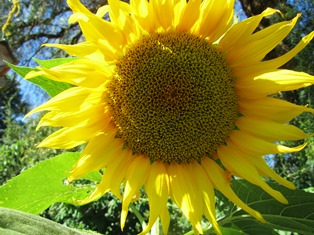
Grow giant sunflowers at the back of the garden or along a fence to support thick stalks and large dinner-plate sized heads
We planted a few sunflowers this year. One rises up maybe ten feet tall and its thick stalk supports a head the size of a toilet seat, no kidding. Sunflowers are beloved by many gardeners because they have myriad uses.
A few notable things about sunflowers: their lovely yellow petals can be used to make dye. Their stalk pith can be used to make paper. The seeds feed humans as well as animals and birds. And oil from the seed is used in cooking and also to create assorted cosmetic products and soaps.
Growing sunflowers is easy and the plant itself is fairly trouble-free. They like their summers hot and long and thrive in plenty of sunshine. You can plant them along a fence to help support the giant heads and thick stalks or tuck the smaller sized sunflowers into beds. They aren’t fussy about soil and do best when watered deeply but not often.
They attract butterflies, bees, birds, and squirrels. Dry the heads by hanging them upside down. I like to buy organic, non-genetically modified seed and save it from the heads each year in paper envelopes to plant the next summer.
Stressed-out Tomatoes and Corn
This has been a tough season for my tomatoes because of the heat wave California (and the southwest) recently endured and the gophers that showed up early.
The heat topped out at 105 degrees Fahrenheit on my patio this week. The patio isn’t far from my garden where I have heirloom tomatoes and corn growing. There are cherry and grape tomatoes, slicing tomatoes, a tomatoes for paste. I’m also growing there and elsewhere on the property patches of corn, eggplant, pumpkins, summer squash, and other veggies.
Just when the second planting of corn in my garden had reached the fragile pollination stage, the heat wave hit. Such extreme summer heat stresses corn. In just one week, despite all the watering, an entire section of the corn dried, the moisture of the ears diminished, and some of the dried tassels blew away in the hot wind.
I’m worried that with the global warming problem, we Northern Californians who have always enjoyed the Mediterranean climate here will be experiencing more of this intense heat in coming years.
Garden Tuck-ins and New Plantings
From our Henny Penny Farmette organic garden, I am already harvesting tomatoes, squash, eggplant, peppers, cantaloupe, and ears of corn. But just because I’m harvesting crops now doesn’t mean I’m finished planting for the year.
In fact, in late June and July, while I am enjoying the healthy summer bounty from our garden, I like to think about what else I might plant, like more corn as a succession planting, or tucking in something new where onions or lettuces have been pulled.
In Northern California, we have the dry season (hot weather) and rainy season (cool and wet). The weather is temperate and I have learned to plant vegetables according to when they grow best.
This is the perfect time to plant beans, corn, melons, parsnips, potatoes, pumpkins, radishes, rutabaga, and turnips.
Then as the months of the fall season approach, I plan to tuck in a few cool season crops (bok choy, cabbage, carrot, fava bean, lettuces, peas, radicchio, and spinach) and root vegetables such as turnips, leeks, and onions.
Growing Avocados
My daughter, whose kitchen looks out over a side yard, asked me for an avocado tree. Her birthday was approaching so I suggested the tree be my present to her. We had a thriving avocado years ago along the side yard of our family home. I suppose she missed that tree.
I had no idea that avocados do not necessarily thrive in Northern California. Some cultivars are hardier than others. They are a subtropical fruit tree and mature trees require roughly 150 gallons of water a week to survive (except in winter). They also need a lot of heat, good drainage, and little to no competition from other trees.
The avocado along the fence of our family home (the tree belonged to our neighbor) eventually became infested with termites. The tree was cut down to about two feet tall, treated, and it bounced back.
The tree I planted for my daughter made it through the East Bay winter here last year and it snowed, albeit just a dusting. So I was pleasantly surprised to see how well the tree is doing now. My daughter hopes for fruit this year or next. We’ll see.
Avocado trees need to be fed throughout the year. They need nitrogen (but also phosphorus and potassium) in a balanced fertilizer like Scotts Turf Supreme. The trees are shallow rooted and like sandy loam soil. Clay soil like what we have here on the farmette must be amended with gypsum and compost.
Some avocados will need a pollinator; others like Stewart, the type of avocado I planted for my daughter, is self-fertile. If you keep bees or live near a beekeeper, the bees will do the pollinating for you. Otherwise you might need to hand pollinate using a small brush. For more information, see http://www.gardenguides.com/108300-pollinate-avocado-trees.html
 Facebook
Facebook Goodreads
Goodreads LinkedIn
LinkedIn Meera Lester
Meera Lester Twitter
Twitter





